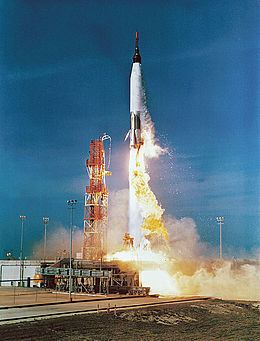Mission type Test flight Spacecraft Mercury No.6 Apogee 183,000 m Launch mass 1,154 kg Launch date 21 February 1961 | Mission duration 17 minutes, 56 seconds Manufacturer McDonnell Aircraft Distance travelled 2.305 million m Date 21 February 1961 Landing date 21 February 1961 | |
 | ||
Mercury-Atlas 2 (MA-2) was launched unmanned on February 21, 1961 at 14:10 UTC, from Launch Complex 14 at Cape Canaveral, Florida.
Test objectives for this flight were concerned with the ability of the spacecraft to withstand reentry under the temperature-critical abort conditions and with the capability of the Atlas to meet the proper injection conditions. Convair had promised to deliver thicker-skinned Atlas vehicles for subsequent flights, however Missile 67D was the last of the thin-skinned model and so it had to be modified for the Mercury mission, incorporating a stainless steel reinforcing band installed around the vehicle between stations 502 and 510. A thin sheet of asbestos was installed between the reinforcing band and the tank skin. This modification was installed as a precaution against the type of failure which had occurred on the previous MA-1 flight. The booster's flight path was also modified somewhat from Mercury-Atlas 1, being placed on a more shallow trajectory so as to reduce aerodynamic loads.
The Atlas lifted into a clear blue February sky quite different from the cloudy, foggy weather of the MA-1 flight. Everyone in the blockhouse waited nervously for the vehicle to pass through the critical Max Q zone. When it did so successfully, there was "enormous jubilation" from the launch team. MA-2 flew a successful suborbital mission that lasted 17 minutes 56 seconds. Altitude reached was 114 miles (183 km), speed, 13,227 mph (21,287 km/h). All test objectives were fully met, the only problems being a bit of propellant slosh. The capsule was recovered 1,432 miles (2305 km) downrange. Peak acceleration was 15.9 g (156 m/s²). Mass 1,154 kg.
Mercury spacecraft #6 and Atlas #67-D were used in the Mercury-Atlas 2 mission. The Mercury capsule is currently displayed at the Houston Museum of Natural Science, Houston, TX.
